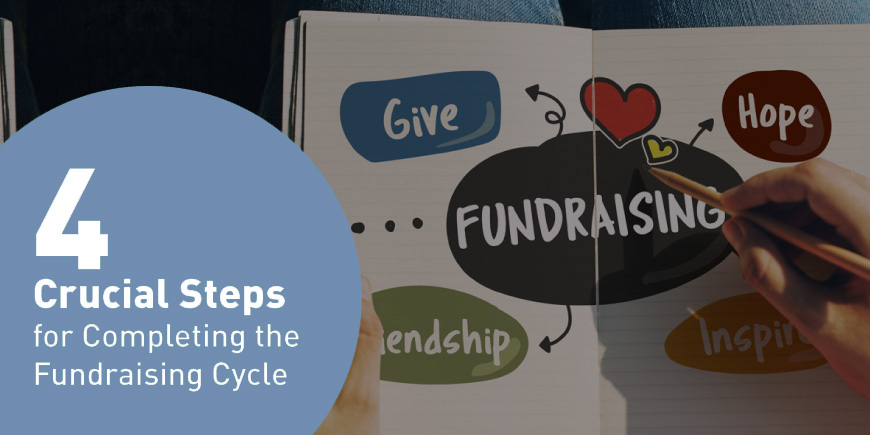This is a guest post written by Adam Weigner, President of Double the Donation.
Fundraising is both a challenging and rewarding part of the nonprofit sphere. The rewards come with the donation revenue and the impact that it makes. However, the challenge comes with how you raise that revenue.
You may have heard of the fundraising cycle, but have you dug into what it entails? It’s an important element that can make or break your strategy.
The fundraising cycle is made up of crucial steps that can impact your success in terms of fundraising. These steps include:
- Identification
- Cultivation
- Solicitation
- Recognition
Your fundraising strategy should be well-thought-out and take these crucial steps into account. Let’s take a closer look at what each specific step entails.
1. Identification
The first step toward completing your fundraising cycle is identifying your potential donors. If you have an organized system of identifying and segmenting your donor prospects, you’ll be more likely to receive donations because you’ll make informed and well-researched fundraising asks.
The identification step includes:
- Prospect research. This type of research entails learning more about potential or existing donors’ backgrounds, giving histories, wealth indicators, and philanthropic motivations. Performing this research allows you to evaluate their ability and willingness to give. In general, look for prospects who have the ability to donate, believe in your cause, and are in contact with your organization.
- CRM database organization. By using robust nonprofit CRMs, you can keep all of your donor profiles and data organized and segment it further into the ages, demographics, etc. that you are targeting. This is a great tool that allows you to look through your previous donors and find one-time donors, low-level recurring gift donors, and volunteers.
By determining factors like willingness and ability to give, as well as an individual’s interest in your nonprofit’s cause, you can make more informed fundraising asks and increase your donation revenue. Compile a list larger than the amount of donors that you need because individuals will naturally drop off throughout the fundraising cycle.
You should also use your CRM as a powerful tool to identify prospects you already have a relationship with. Not sure where to start with your prospect research? Check out these tips.
2. Cultivation
Cultivation is arguably the most important step toward completing the fundraising cycle, and should occupy a large amount of your focus. Typically, this period of time lasts between 6 and 12 months.
The main idea behind this step is that you should treat the donor like a whole person, not just a potential revenue boost.
This means donors need to be considered an integral part of your nonprofit, allowing you to build loyalty and long-term relationships with them. During the cultivation step, you should learn what your prospects’ interests and passions are and what motivates them to give.
In order to center your fundraising around your donors, try the following strategies:
- Keep your CRM updated. You should update your donor database to include each interaction you’ve had with your donors. This will ensure you can personalize your outreach and understand what topics have already been covered with them. Keeping everyone at your nonprofit on the same page is key!
- Invite your donors to witness your programs firsthand. Invite your donors to see your nonprofit in action so they can see firsthand how their donations are beneficial. Or invite them to fundraising events, like charity auctions. Offering a variety of engagement opportunities like these can strengthen your relationship with your donors.
- Ask for donor feedback. Invite your donors to offer feedback about what your nonprofit can do better. Be sure to actively listen to their feedback and incorporate it when appropriate, as well.
- Publicly recognize your donors. Acknowledge milestones in your donors’ lives and also look for ways to thank and recognize your donors publicly.
Cultivation plays a large role in completing the fundraising cycle. Double the Donation compares this process to tending to a growing tree: You have to care for it before it becomes fully grown, just like you need to care for your prospect relationships. But you don’t want to overwater the tree, just as you don’t want to overdo it when interacting with prospects.
Be sure to center much of your focus on this step, and you’ll be on your way to raising the funds you need.
3. Solicitation
Believe it or not, but people say the main reason they don’t donate is because they’re not asked. It’s true—you’re more likely to receive donations if you directly ask for them.
You should know your donors’ communication preferences, how much to ask for, and how frequently you should ask based on your CRM database. Using this information, you can begin your outreach. Some communication options include:
- Direct mail. Use direct mail to reach out to your supporters. Mail merge tools and templates for donation requests make this easier, and you can pull all the contact information you need from your CRM database.
- Email. Email shouldn’t be used to ask for major gifts, but they’re one of the most cost-effective ways to raise money and great for mass communication.
- Social media. Though this is a more casual fundraising method, this is a great way to spread the word about your cause. Once you have your audience’s attention, direct them to your online donation page.
- In-person. This is a great method to ask for contributions from major gift donors, as well as corporate donations. It’s also an effective way to ask donors for second gifts.
- Over the phone. Be sure to hold your phone conversations at optimal times and talk up your organization and campaigns you’re running.
- Online. Set up a secure and branded online donation page on your website that allows visitors to donate directly through your site.
Once you’ve decided how you’re going to reach out to your prospects, you need to follow some best practices in your actual verbiage. For example, you should:
- Personalize each ask. Avoid sending every prospect the same message. Recipients can tell when communication is sent out en masse, rather than personalized to them. Put the donor’s name on every piece of material.
- Include marketing materials. Detail your nonprofit’s future plans and goals to keep your recipients in the loop and offer more information for them to make their decision. Make sure what you send them is based on what you know inspires them to donate.
- Base your ask amount on your research. Be aware of your prospects' financial situation and previous donation sizes so that you can suggest an appropriate gift amount.
Soliciting donations can be intimidating, but your solicitation is a crucial step to getting through the fundraising cycle. If you’re still unsure of where to start, check out Double the Donation’s guide to asking for donations.
4. Recognition
In order to complete the fundraising cycle, it’s important to maintain your relationships with your donors. Recognition is the most impactful way to ensure your donors feel appreciated and continue offering their support in the future. You should also show donors how their contributions are being used.
Follow these tips for adequately recognizing your supporters:
- Keep in contact. Keep your donors in the loop and personalize your communication with them as much as possible. This could be in the form of email updates, newsletters, and in-person meetings. Even sending a handwritten thank-you note after a gift is made or sending a Christmas card will make your donors feel involved.
- Say thank you. Always follow-up immediately with a thank-you message after receiving a donation of any kind. This should be separate from the donation receipt the donor receives. Explain how their gift is benefiting your nonprofit and the groups you help.
- Keep up the recognition. Keep your donors’ names in a prominent place, such as on your website and in your annual report, as well as on physical structures, like donor recognition walls.
- Plan both public and private events. Invite your donors to private events, which demonstrates your appreciation, but also invite them to public events so they still feel like they’re part of your main community.
- Be authentic. Demonstrate your donors’ impact via images or stories.
- By being authentic, as well as transparent, about what your nonprofit does, you instill trust and confidence in your supporters that their donations are going to the greater good.
Engaging your donors is imperative to making them feel appreciated and keeping them involved in your organization. By keeping in contact, showing gratitude, and being authentic, you can demonstrate to donors how your nonprofit makes a difference and why your relationship with them is so important.
Now that we’ve dug into the crucial steps for completing your fundraising cycle, you should have a more solid foundation you can use to build out your strategy for raising money. By identifying, cultivating, soliciting, and recognizing your donors, you’ll be on your way to raising more revenue and establishing long-lasting relationships!


Comments
Questions or comments? Join the conversation!